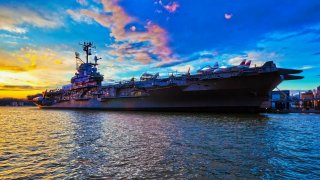How a Submarine Could Sink a U.S. Navy Aircraft Carrier No Problem
Advancements in naval technology, defensive strategies, and the presence of long-range weaponry suggest that the threat landscape for aircraft carriers extends beyond the capabilities of submarines alone, making the likelihood of such an attack today more complex and multifaceted.
Summary: During World War II, the Imperial Japanese Navy's aircraft carrier Shinano, the largest warship sunk by a submarine, was defeated by the USS Archerfish, marking a significant loss of 1,435 sailors. This event raises questions about the vulnerability of modern supercarriers, such as the U.S. Navy's Nimitz-class and Gerald R. Ford-class, which have larger crews but have yet to face a similar fate. Historical instances and naval exercises, including the simulated sinking of the USS Ronald Reagan by the Swedish submarine HSMS Gotland, demonstrate that submarines could pose a threat to carriers if they manage to bypass protective measures. However, advancements in naval technology, defensive strategies, and the presence of long-range weaponry suggest that the threat landscape for aircraft carriers extends beyond the capabilities of submarines alone, making the likelihood of such an attack today more complex and multifaceted.
Aircraft Carriers: Nearing the End?
During the Second World War, the Imperial Japanese Navy aircraft carrier Shinano – which had been laid down as a Yamato- class battleship before being converted to a flattop – was sunk on November 29, 1944, 65 miles off the coast of the Japanese home island of Honshu after taking four torpedoes from the U.S. Navy submarine USS Archerfish (SS-311).
Shinano was the largest warship ever sunk by a submarine, and 1,435 sailors went down with the ship, including her captain.
Were a U.S. Navy's Nimitz-class or Gerald R. Ford-class carrier to meet a similar fate, the loss of life could be even greater. The nuclear-powered carriers have a complement of around 5,000 and 4,500 respectively. No U.S. Navy aircraft carrier has indeed been sunk since World War II, but of the dozen flattops sunk by the enemy, four were from submarines.
That included the Bogue-class escort carrier USS Block Island (CVE-21), the only U.S. carrier lost in the Atlantic after she was torpedoed off the Canary Islands on May 29, 1944, by U-549. Six crewmen were killed, but the remaining 941 were picked up by the escorting destroyers, which also successfully sank the German U-boat.
In addition, five Royal Navy and 10 Imperial Japanese Navy aircraft carriers were also sunk by torpedoes fired from submarines.
Could a Submarine Sink a Supercarrier?
The question to ask now is whether the same threat remains to carriers today, but this remains fully hypothetical. In fact, the Royal Navy's Churchill-class fleet submarine HMS Conqueror has the distinction of being the only nuclear-powered boat to have engaged an enemy ship with torpedoes, the Argentine Navy light cruiser ARA General Belgrano (C-4), former the U.S. Navy's USS Phoenix.
She was sunk on May 2, 1982, during the Falklands War with the loss of 323 lives – and remains the largest warship lost in combat since the Second World War.
Naval exercises do suggest that submarines could sink a carrier if they can get close enough. Such was the case in a 2005 anti-submarine warfare (ASW) exercise involving the U.S. Navy's Nimitz-class aircraft carrier USS Ronald Reagan (CVN-76), which was "sunk" by the Swedish Navy's HSMS Gotland (A-19).
The outcome was replicated multiple times and the stealthy Swedish sub was able to "run rings" around the then newly constructed $6.2 billion aircraft carrier, and its strike group.
As Stavros Atlamazoglou wrote for The National Interest , "Despite having an entire carrier strike group, including destroyers, helicopters, and planes hunting for it, the HSMS Gotland managed to sneak by the formidable anti-submarine defensive net around the USS Ronald Reagan and score several simulated torpedoes 'hits.'"
The U.S. Navy held multiple exercises with the Gotland – which it leased from the Swedish Navy – over the course of a year, and each time the submarine successfully and silently maneuvered around destroyers and nuclear attack submarines. U.S. officials were so impressed (and likely dismayed) that they leased the Swedish boat for another year to understand how it went undetected so successfully.
In another exercise, this time involving the U.S. Navy's Los Angeles-class nuclear-powered attack submarine USS Dallas (SSN-700), the boat stealthily evaded detection and simulated a successful attack on the Royal Navy carrier HMS Illustrious.
A Few Considerations
Though numerous reports have suggested that the Gotland-class Swedish submarine could have sunk that U.S. carrier, it was still only a drill. As Atlamazoglou further noted, the USS Ronald Reagan still has a top speed of more than 30 knots, about 35 miles per hour, which is most impressive for a ship weighing 100,000 plus tons.
Moreover, even if the HSMS Gotland had been a real enemy, the U.S. aircraft carrier would have picked up the torpedoes and initiated evasive maneuvers to avoid them. Then there is the fact that supercarriers like the USS Ronald Reagan are extremely well-armored and could probably withstand several hits from the small Swedish sub.
Carriers are also highly protected vessels, and it is the job of destroyers, submarines, and other escorts – not to mention the airwing of fighters, early warning aircraft, and anti-submarine warfare (ASW) helicopters – to ensure that nothing gets through. Yet, the USS Block Island was also being escorted back in 1944 and a U-boat slipped through and fired its lucky shot. Though the ring is more secure, an enemy just needs a fair amount of luck today.
Finally, luck and submarines may be an entirely moot point. Given the development of long-range missiles, stealth aircraft and long-range nuclear-armed torpedoes, the dangers to a carrier and its strike group go way beyond just a submarine.
Author Experience and Expertise: Peter Suciu
Peter Suciu is a Michigan-based writer. He has contributed to more than four dozen magazines, newspapers, and websites with over 3,200 published pieces over a twenty-year career in journalism. He regularly writes about military hardware, firearms history, cybersecurity, politics, and international affairs. Peter is also a Contributing Writer for Forbes and Clearance Jobs. You can follow him on Twitter: @PeterSuciu. You can email the author: [email protected].
Image Credit: Shutterstock.


